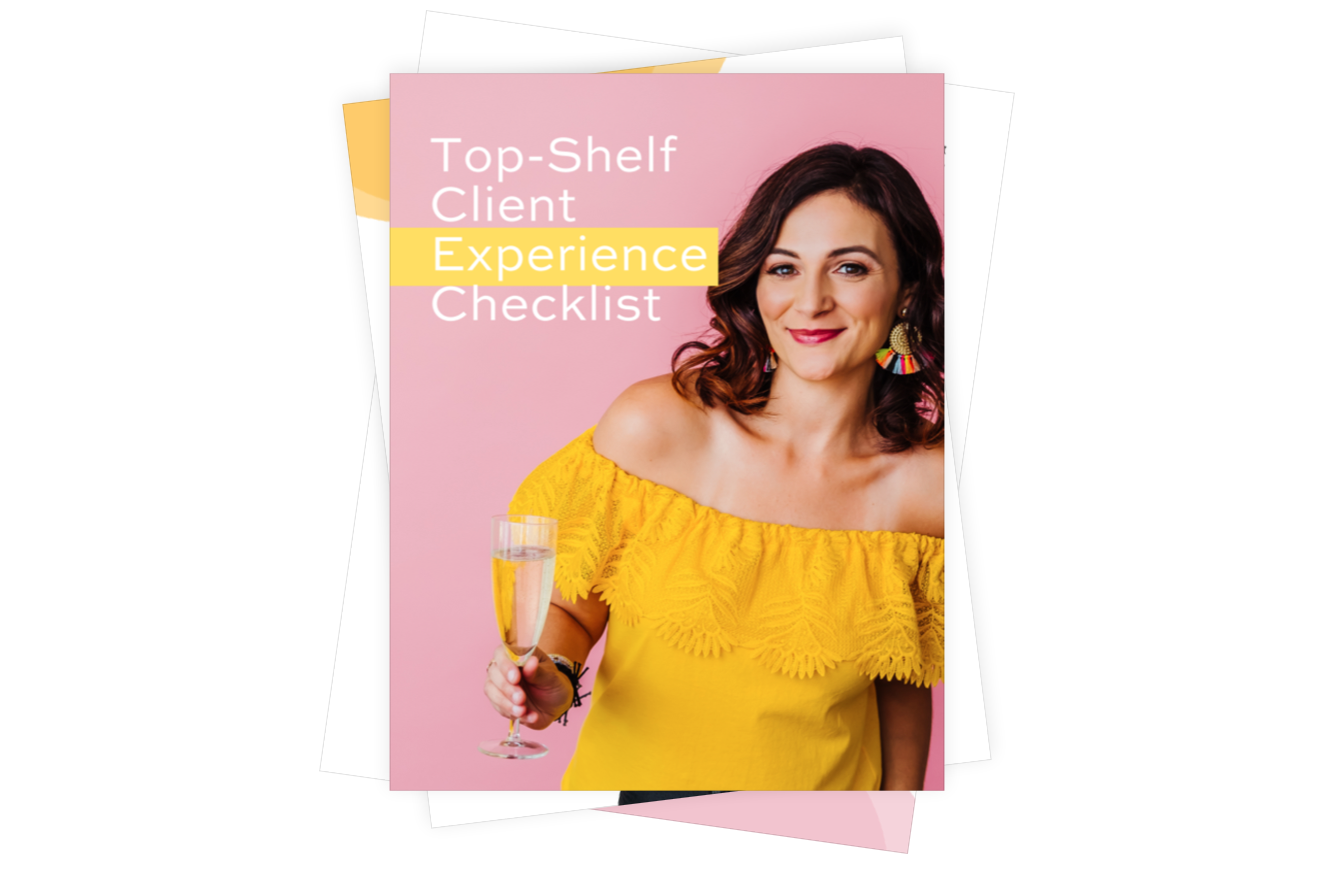
APPLE PODCASTS | SPOTIFY
My Time-Saving, Client-Experience Elevating Secret …
My business has been built on referrals and repeat business. I think the number one reason for that is not only am I good at copywriting, but I also put a lot of effort into taking good care of my clients. Communication is the number one thing. When there is a lack of communication relationships can turn south or fall through the cracks.
I don’t love meetings, so I have put a lot of energy and focus into streamlining my client communication process via email and Dubsado. From the time a lead comes into the time I’m requesting their testimonial the communication is super clear and super consistent via email. I think it saves time on both of our ends versus trying to hop on a call every time we want to communicate.
So today I want to talk about the thirteen pre-written emails you should have in your business if you are a service provider.
People in the online marketing industry talk a lot about systems – implementing systems and automation in your business. I believe one of those first systems most service-based entrepreneurs should start with is streamlining their customer experience. The most effective way to elevate the customer experience and instantly get more time back in your day is to create canned emails or email templates. I prefer templates- like scripts and guided responses. It’s a combination of all of those things, but when you have a go-to folder of these pre-written templates, you can spend less time in your inbox rewriting.
You might be thinking, “Ugh, like canned emails. That sounds so gross. No one wants a canned email.” The word template seems super sterile and impersonal. Or you might be thinking, “you know, it doesn’t take that much time to write each of these emails on the fly as they come up.” I am going to challenge you on that. I would encourage you over the next week to look at how much time you spend in your inbox writing all your client communication. Do a time audit of how much time you actually spend on that kind of communication and you’ll see that you could probably get back one to two hours a week by just having these emails in your back pocket.
Rethink how you initially thought about email templates. Canned email templates do not need to sound canned or be totally canned when you really take the time to write these out thoughtfully. They are going to turn out better than anything you might write on the fly when you’re rushed. Think of these as a starting point or a guided response. These actually allow you to deliver a higher, more personalized level of service.
The secret to creating emails you can use over and over again without sounding generic is striking balance. There are some emails – a response to a lead – that can be the same for every client from the beginning to end. You don’t need to re-edit that email each time. Same with a missed call, invoice, missed payment templates… all of those can be the exact same for every single client. You don’t need to reinvent the wheel, but you can add a little bit of personality to them to make them sound a little bit more exciting than your standard auto-response.
Once you write all these email templates, go to your CRM like Dubsado, 17 hats, or HoneyBook and load them all in as canned emails. If you don’t use a CRM, you can keep them all in Google doc and just copy and paste from them as needed. I happen to use Gmail, and there’s actually a feature where you can create folders of canned emails. Gmail makes it easy when writing an email- you click on the little icon at the bottom and you just pull up the email so that you’re never starting the email from scratch, which is seriously game-changing.
My biggest tip for you is when you sit down to write these emails, start them by writing to an actual person versus sitting down and thinking “Okay, I’m going to sit down and write a bunch of templates.” Next time you get a lead, sit down and write your response back to them. Would you actually send this in a one-on-one email?
Next, let’s talk you through a checklist of the essential business-to-business client communication emails that I use in my business. I’ve put all of these into a free PDF checklist and you can grab that at www.erikaholmes.com/checklist.
Your 13 time-saving client communication emails
1. Get them on the phone inquiry response
A lead will come in one of a few ways: email, direct message, or the intake form on your website. Once they submit their inquiry, the ball’s in your court in terms of keeping the momentum going and getting them to schedule a call. So, as you’re writing this one, put some thought into how you’re going to motivate them to continue the conversation with you.
You’ll want to express some gratitude and genuine excitement. But you also want to give them a clear next step in your vetting process. Ideally, you want this email to go out within 24 hours of their inquiry. I use Dubsado, so my response goes out automatically. It is the exact same for every new person who contacts me. I used to take my time with each of these, which in the beginning was great. It was super high-touch and it served me well. It was doable when I was getting maybe a couple of leads a month, but now that I’m getting multiple leads a week, there’s just no possible way I could sustain that. So instead, I just looked through all the emails I had written previously to new leads and I created one that can serve everyone.
2. The missed call
Aka the let’s reschedule email template because life happens, right? Calendar reminders don’t go out, people might have second thoughts or they might get busy, but that doesn’t mean you shouldn’t try to reach out and reschedule the call. Instead of awkwardly fumbling for the right words each time, write a fun personality-packed email that reminds them of why they booked a call with you in the first place. Then try to get them to reschedule. I highly recommend using a scheduler like Calendly, Acuity or Dubsado to end the back and forth of scheduling a time. A well-written missed call-template can rekindle the connection between the client and your offering. It can jumpstart that sense of excitement if you can come up with a fun way to try and get them back on the phone with you.
3. The the speech before the proposal
Usually, when you’re sending a proposal to a client, you are sending it in an email or through your CRM, right? When you are asking somebody to spend their hard-earned money with you, you better bring it in this email. That means you need to be teeing up your proposal with an irresistible “this person gets me” email. The key to making this email make an impact is reiterating their challenges back to them and queueing the solution that you are delivering.
4-6. The proposal
If you’re not strategically following up after you hit send on a proposal, you could be leaving massive amounts of money on the table. I recommend crafting three follow-up emails each with its own specific goal in mind. These can be short and sweet, but effective in getting more people to say yes, making sure you don’t get ghosted, and just hearing why someone is saying no to you. How many times have you sent a proposal and never heard from somebody again? That used to happen to me in the beginning, but when I started implementing these follow-ups, you get more insight as to what’s holding people back and you can then tailor the proposal.
7. The invoice
Asking for money can be awkward, but I’m going to invite you to resist the urge to let your invoicing software’s generic language do the asking because yes, you can let Wave or QuickBooks or even Dubsado just send out their automated a payment is due’ email, but your client is signing up to work with you, not a robot.
I believe that every touchpoint, no matter how small, is an opportunity to infuse your brand personality into it. I would encourage you to craft a non-automated-sounding email that gets your client excited to put down that deposit and start the process. This can be a super short email with a fun gif that can be the same for every single client. So write it once and you’re done.
8. The late payment reminder
Reminding somebody that they’re late on a payment can be even more awkward than asking for that first payment in the first place. Instead of sending a robotic automated reminder or spending twenty minutes writing a few words and then hitting delete, spend some time creating a go-to template for this. This will happen. So you want to make sure that you have an email in place for when it does. The phrase gentle reminders should not be a part of this email. You want to let them off the hook for the first time around, but also make sure that they pay you. There is a way to do that tastefully, but firmly and even with a little bit of humor.
9. New client welcome
Your brand new client just took out their credit card for you and digitally swiped it. Maybe they even had a little minor panic attack when they clicked that pay now button. The new client welcome email is your opportunity to be that celebratory glass of champagne that welcomes them into your world, puts them at ease, guides them towards their next step, and makes them feel confident that they’ve just made the right decision investing with you.
This email will probably be the same for each new client. There’s no need to invent the wheel here! Maybe you need to personalize it depending on what service they’re signing up for.
The goal of this email should be:
1. To make them feel really good about their decision
2. To give them a feel for what comes next.
In my template, I’m letting people know what to expect, what the next steps are, and what actions to take. So as you’re writing this, make a list of what they need to do next or what they need to know next to turn it into a template that you can use over and over again.
10. Scope Creep
It is an evitable your clients will ask for a little something, something extra here and there. It’s going to be up to you in that moment whether to say yes or no. What I have learned is, in order to avoid that knee-jerk response to a scope creep request, it pays to have a pre-written reply that honors your boundaries and to make sure you’re compensated for anything that’s above and beyond what you promise. In general, you want to have some sort of response prepared that will gently remind your client what you agreed upon in the scope and what it would require for you to add this new request into it.
11. Weekly check-in
The last thing I want is for clients who have put down money to work with me is for them to think that I’ve forgotten about them. Sometimes we get so wrapped up in our other client work that we assume our clients are doing fine, but we don’t want to leave them hanging. We want to give them that VIP feeling. The minute a client signs up to work with me I am checking up with them. If not weekly, then at least bi-weekly where I’m just popping in to say, “I’m super excited to work with you. Here’s where our project stands. Here’s what I may need you to do next.” This is one of those emails where you may need to customize it each time, depending on where you are in the project, but it’s helpful to at least have a starting point.
When I send this every week, I just log into Dubsado, pull up the saved template, go in and customize the middle part. Your clients are going to love you for it because it shows them that you haven’t forgotten about them. And again, it makes sure that this communication is constantly happening. You’re also building a relationship as you do this because it will start a little bit of a back and forth.
12. Testimonial request
Getting testimonials right after a project closes is essential to getting authentic, detailed feedback. Have a pre-written thank you/testimonial request email that you can send to each new client after your project wraps up. I actually did an entire episode on how to ask for a testimonial. That was episode four, where I go in-depth on how to request testimonials.
13. 60-day check-in
The last email template you want to have is your 60-day check-in. Fun fact, it is seven times easier to sell to an existing, happy client than it is to find a new one. That’s why keeping in touch with intention is a really strategic way to elevate your customer service while potentially getting more business from the same clients. Having a fill-in-the-blank email with prompts makes it effortless to stay in touch, request referrals, and land that follow-up project. I have it set up in Dubsado where 60 days after a client pays their final invoice, a reminder to send them a sixty-day check-in pops up. I always personalize this one because I like to poke around on their social media or take a look at our recent conversations and tie that into the email. So this 60-day check-in is a really great way to keep your clients close to you, keep yourself top of mind, and potentially get referrals.
Here is a recap of essential client communication emails:
1. Your inquiry response.
2. Your missed call – the reschedule email.
3. The email accompanying the proposal – so the speech before the proposal.
*Numbers 4, 5, and 6 are the proposal follow-up emails, so those are three emails total.*
7. The first invoice.
8. The missed payment.
9. The new client welcome.
10. The scope creep.
11. Our weekly check-in
12. Your testimonial request
13. The 60-day check-in.
Now, remember to grab my free checklist, which outlines all of these. You can grab that at www.erikaholmes.com/checklist.
If you’re interested in trying Dubsado, here’s my link for a little discount: https://www.dubsado.com/?c=erikaholmes.
I hope you found this helpful or it changed your mind on the idea of canned email templates. Did it inspire you to sit down and start writing your own templates? Tell me all about it below!


